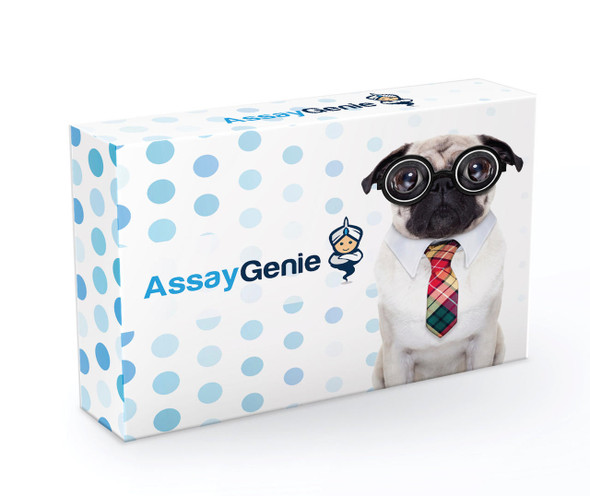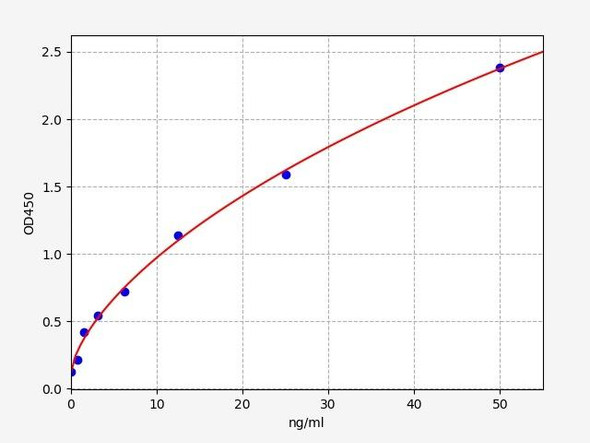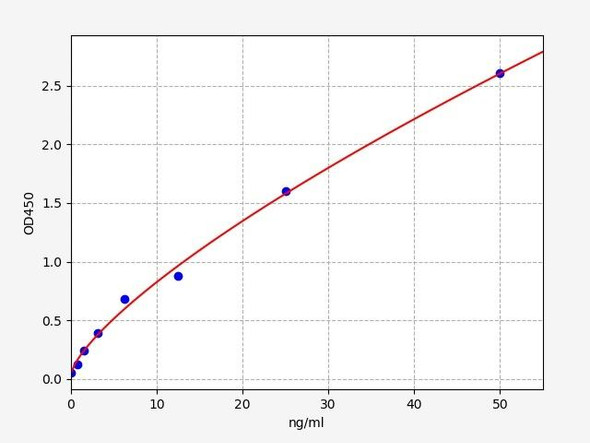Mouse Angiotensin-converting enzyme (Ace) ELISA Kit (MOEB0003)
- SKU:
- MOEB0003
- Product Type:
- ELISA Kit
- Size:
- 96 Assays
- Uniprot:
- P09470
- Range:
- 78-5000 pg/mL
- ELISA Type:
- Sandwich
- Synonyms:
- ACE, ACE1, CD143, DCP, DCP1, ICH, MVCD3
- Reactivity:
- Mouse
Description
Mouse Angiotensin-converting enzyme (Ace) ELISA Kit
The Mouse Angiotensin-Converting Enzyme (ACE) ELISA Kit is a powerful tool for the precise measurement of ACE levels in mouse serum, plasma, and tissue lysates. With its superior sensitivity and specificity, this kit delivers accurate and consistent results, perfect for diverse research applications.ACE is a key enzyme involved in the regulation of blood pressure and fluid balance, critical for maintaining cardiovascular health.
Dysregulation of ACE has been linked to various cardiovascular and renal diseases, making it a valuable biomarker for studying these conditions and exploring potential therapeutic interventions.Discover more about ACE and its role in mouse physiology with the Mouse Angiotensin-Converting Enzyme (ACE) ELISA Kit, a reliable and efficient solution for your research needs.
| Product Name: | Mouse Angiotensin-converting enzyme (Ace) ELISA Kit |
| SKU: | MOEB0003 |
| Size: | 96T |
| Target: | Mouse Angiotensin-converting enzyme (Ace) |
| Synonyms: | Dipeptidyl carboxypeptidase I, Kininase II, CD143, ACE, Dcp1 |
| Assay Type: | Sandwich |
| Detection Method: | ELISA |
| Reactivity: | Mouse |
| Detection Range: | 0.312-20ng/mL |
| Sensitivity: | 0.11ng/mL |
| Intra CV: | 5.4% | ||||||||||||||||||||
| Inter CV: | 9.1% | ||||||||||||||||||||
| Linearity: |
| ||||||||||||||||||||
| Recovery: |
| ||||||||||||||||||||
| Function: | Converts angiotensin I to angiotensin II by release of the terminal His-Leu, this results in an increase of the vasoconstrictor activity of angiotensin. Also able to inactivate bradykinin, a potent vasodilator. Has also a glycosidase activity which releases GPI-anchored proteins from the membrane by cleaving the mannose linkage in the GPI moiety. This GPIase activity seems to be crucial for the egg-binding ability of the sperm. |
| Uniprot: | P09470 |
| Sample Type: | Serum, plasma, tissue homogenates, cell culture supernates and other biological fluids |
| Specificity: | Natural and recombinant mouse Angiotensin-converting enzyme |
| Subcellular Location: | Cell membrane Single-pass type I membrane protein Cytoplasm Detected in both cell membrane and cytoplasm in neurons. |
| Storage: | Please see kit components below for exact storage details |
| Note: | For research use only |
| UniProt Protein Function: | ACE: Converts angiotensin I to angiotensin II by release of the terminal His-Leu, this results in an increase of the vasoconstrictor activity of angiotensin. Also able to inactivate bradykinin, a potent vasodilator. Has also a glycosidase activity which releases GPI-anchored proteins from the membrane by cleaving the mannose linkage in the GPI moiety. Genetic variations in ACE may be a cause of susceptibility to ischemic stroke (ISCHSTR); also known as cerebrovascular accident or cerebral infarction. A stroke is an acute neurologic event leading to death of neural tissue of the brain and resulting in loss of motor, sensory and/or cognitive function. Ischemic strokes, resulting from vascular occlusion, is considered to be a highly complex disease consisting of a group of heterogeneous disorders with multiple genetic and environmental risk factors. Defects in ACE are a cause of renal tubular dysgenesis (RTD). RTD is an autosomal recessive severe disorder of renal tubular development characterized by persistent fetal anuria and perinatal death, probably due to pulmonary hypoplasia from early-onset oligohydramnios (the Potter phenotype). Genetic variations in ACE are associated with susceptibility to microvascular complications of diabetes type 3 (MVCD3). These are pathological conditions that develop in numerous tissues and organs as a consequence of diabetes mellitus. They include diabetic retinopathy, diabetic nephropathy leading to end-stage renal disease, and diabetic neuropathy. Diabetic retinopathy remains the major cause of new- onset blindness among diabetic adults. It is characterized by vascular permeability and increased tissue ischemia and angiogenesis. Defects in ACE are a cause of susceptibility to intracerebral hemorrhage (ICH). A pathological condition characterized by bleeding into one or both cerebral hemispheres including the basal ganglia and the cerebral cortex. It is often associated with hypertension and craniocerebral trauma. Intracerebral bleeding is a common cause of stroke. Belongs to the peptidase M2 family. 4 isoforms of the human protein are produced by alternative splicing. |
| UniProt Protein Details: | Protein type:Protease; Membrane protein, integral; EC 3.4.15.1 Cellular Component: extracellular space; membrane; brush border membrane; lysosome; cytoplasm; plasma membrane; integral to membrane; basal plasma membrane; extracellular region; endosome; vesicle; external side of plasma membrane Molecular Function:metallopeptidase activity; carboxypeptidase activity; zinc ion binding; mitogen-activated protein kinase kinase binding; mannosyl-oligosaccharide mannosidase activity; metal ion binding; drug binding; actin binding; glucosidase activity; endopeptidase activity; mitogen-activated protein kinase binding; amylase activity; chloride ion binding; peptidyl-dipeptidase activity; tripeptidyl-peptidase activity; hydrolase activity; trehalase activity; peptidase activity; protein binding; fucosidase activity; hexosaminidase activity; lytic transglycosylase activity; galactosidase activity; bradykinin receptor binding; exopeptidase activity; mannosidase activity Biological Process: positive regulation of protein binding; positive regulation of apoptosis; neutrophil mediated immunity; response to lipopolysaccharide; positive regulation of systemic arterial blood pressure; regulation of angiotensin metabolic process; proteolysis; sensory perception of pain; peptide metabolic process; regulation of smooth muscle cell migration; peptide catabolic process; beta-amyloid metabolic process; regulation of blood pressure; kidney development; negative regulation of protein binding; vasoconstriction; positive regulation of neurogenesis; organ regeneration; eating behavior; arachidonic acid secretion; regulation of systemic arterial blood pressure by renin-angiotensin; heart contraction; spermatogenesis; hormone catabolic process; alveolus development; positive regulation of inflammatory response |
| UniProt Code: | P09470 |
| NCBI GenInfo Identifier: | 73920183 |
| NCBI Gene ID: | 11421 |
| NCBI Accession: | P09470.3 |
| UniProt Related Accession: | P09470 |
| Molecular Weight: | |
| NCBI Full Name: | Angiotensin-converting enzyme |
| NCBI Synonym Full Names: | angiotensin I converting enzyme (peptidyl-dipeptidase A) 1 |
| NCBI Official Symbol: | Ace |
| NCBI Official Synonym Symbols: | CD143; AW208573 |
| NCBI Protein Information: | angiotensin-converting enzyme |
| UniProt Protein Name: | Angiotensin-converting enzyme |
| UniProt Synonym Protein Names: | Dipeptidyl carboxypeptidase I; Kininase II; CD_antigen: CD143Cleaved into the following chain:Angiotensin-converting enzyme, soluble form |
| Protein Family: | Acetylcholinesterase |
| UniProt Gene Name: | Ace |
| UniProt Entry Name: | ACE_MOUSE |
| Component | Quantity (96 Assays) | Storage |
| ELISA Microplate (Dismountable) | 8×12 strips | -20°C |
| Lyophilized Standard | 2 | -20°C |
| Sample Diluent | 20ml | -20°C |
| Assay Diluent A | 10mL | -20°C |
| Assay Diluent B | 10mL | -20°C |
| Detection Reagent A | 120µL | -20°C |
| Detection Reagent B | 120µL | -20°C |
| Wash Buffer | 30mL | 4°C |
| Substrate | 10mL | 4°C |
| Stop Solution | 10mL | 4°C |
| Plate Sealer | 5 | - |
Other materials and equipment required:
- Microplate reader with 450 nm wavelength filter
- Multichannel Pipette, Pipette, microcentrifuge tubes and disposable pipette tips
- Incubator
- Deionized or distilled water
- Absorbent paper
- Buffer resevoir
*Note: The below protocol is a sample protocol. Protocols are specific to each batch/lot. For the correct instructions please follow the protocol included in your kit.
Allow all reagents to reach room temperature (Please do not dissolve the reagents at 37°C directly). All the reagents should be mixed thoroughly by gently swirling before pipetting. Avoid foaming. Keep appropriate numbers of strips for 1 experiment and remove extra strips from microtiter plate. Removed strips should be resealed and stored at -20°C until the kits expiry date. Prepare all reagents, working standards and samples as directed in the previous sections. Please predict the concentration before assaying. If values for these are not within the range of the standard curve, users must determine the optimal sample dilutions for their experiments. We recommend running all samples in duplicate.
| Step | |
| 1. | Add Sample: Add 100µL of Standard, Blank, or Sample per well. The blank well is added with Sample diluent. Solutions are added to the bottom of micro ELISA plate well, avoid inside wall touching and foaming as possible. Mix it gently. Cover the plate with sealer we provided. Incubate for 120 minutes at 37°C. |
| 2. | Remove the liquid from each well, don't wash. Add 100µL of Detection Reagent A working solution to each well. Cover with the Plate sealer. Gently tap the plate to ensure thorough mixing. Incubate for 1 hour at 37°C. Note: if Detection Reagent A appears cloudy warm to room temperature until solution is uniform. |
| 3. | Aspirate each well and wash, repeating the process three times. Wash by filling each well with Wash Buffer (approximately 400µL) (a squirt bottle, multi-channel pipette,manifold dispenser or automated washer are needed). Complete removal of liquid at each step is essential. After the last wash, completely remove remaining Wash Buffer by aspirating or decanting. Invert the plate and pat it against thick clean absorbent paper. |
| 4. | Add 100µL of Detection Reagent B working solution to each well. Cover with the Plate sealer. Incubate for 60 minutes at 37°C. |
| 5. | Repeat the wash process for five times as conducted in step 3. |
| 6. | Add 90µL of Substrate Solution to each well. Cover with a new Plate sealer and incubate for 10-20 minutes at 37°C. Protect the plate from light. The reaction time can be shortened or extended according to the actual color change, but this should not exceed more than 30 minutes. When apparent gradient appears in standard wells, user should terminatethe reaction. |
| 7. | Add 50µL of Stop Solution to each well. If color change does not appear uniform, gently tap the plate to ensure thorough mixing. |
| 8. | Determine the optical density (OD value) of each well at once, using a micro-plate reader set to 450 nm. User should open the micro-plate reader in advance, preheat the instrument, and set the testing parameters. |
| 9. | After experiment, store all reagents according to the specified storage temperature respectively until their expiry. |
When carrying out an ELISA assay it is important to prepare your samples in order to achieve the best possible results. Below we have a list of procedures for the preparation of samples for different sample types.
| Sample Type | Protocol |
| Serum | If using serum separator tubes, allow samples to clot for 30 minutes at room temperature. Centrifuge for 10 minutes at 1,000x g. Collect the serum fraction and assay promptly or aliquot and store the samples at -80°C. Avoid multiple freeze-thaw cycles. If serum separator tubes are not being used, allow samples to clot overnight at 2-8°C. Centrifuge for 10 minutes at 1,000x g. Remove serum and assay promptly or aliquot and store the samples at -80°C. Avoid multiple freeze-thaw cycles. |
| Plasma | Collect plasma using EDTA or heparin as an anticoagulant. Centrifuge samples at 4°C for 15 mins at 1000 × g within 30 mins of collection. Collect the plasma fraction and assay promptly or aliquot and store the samples at -80°C. Avoid multiple freeze-thaw cycles. Note: Over haemolysed samples are not suitable for use with this kit. |
| Urine & Cerebrospinal Fluid | Collect the urine (mid-stream) in a sterile container, centrifuge for 20 mins at 2000-3000 rpm. Remove supernatant and assay immediately. If any precipitation is detected, repeat the centrifugation step. A similar protocol can be used for cerebrospinal fluid. |
| Cell culture supernatant | Collect the cell culture media by pipette, followed by centrifugation at 4°C for 20 mins at 1500 rpm. Collect the clear supernatant and assay immediately. |
| Cell lysates | Solubilize cells in lysis buffer and allow to sit on ice for 30 minutes. Centrifuge tubes at 14,000 x g for 5 minutes to remove insoluble material. Aliquot the supernatant into a new tube and discard the remaining whole cell extract. Quantify total protein concentration using a total protein assay. Assay immediately or aliquot and store at ≤ -20 °C. |
| Tissue homogenates | The preparation of tissue homogenates will vary depending upon tissue type. Rinse tissue with 1X PBS to remove excess blood & homogenize in 20ml of 1X PBS (including protease inhibitors) and store overnight at ≤ -20°C. Two freeze-thaw cycles are required to break the cell membranes. To further disrupt the cell membranes you can sonicate the samples. Centrifuge homogenates for 5 mins at 5000xg. Remove the supernatant and assay immediately or aliquot and store at -20°C or -80°C. |
| Tissue lysates | Rinse tissue with PBS, cut into 1-2 mm pieces, and homogenize with a tissue homogenizer in PBS. Add an equal volume of RIPA buffer containing protease inhibitors and lyse tissues at room temperature for 30 minutes with gentle agitation. Centrifuge to remove debris. Quantify total protein concentration using a total protein assay. Assay immediately or aliquot and store at ≤ -20 °C. |
| Breast Milk | Collect milk samples and centrifuge at 10,000 x g for 60 min at 4°C. Aliquot the supernatant and assay. For long term use, store samples at -80°C. Minimize freeze/thaw cycles. |










